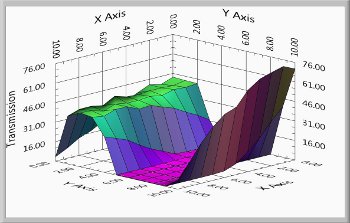CRAIC Technologies, the world leading innovator of microanalysis solutions, is proud to announce Raman Spectral Surface Mapping™ (S2M™) capabilities for its Apollo™ Raman microspectrometer line.
 3D Mapping 675 of LCD ColorMask - Craic Technologies
3D Mapping 675 of LCD ColorMask - Craic Technologies
S2M™ gives CRAIC Raman microspectrometer users the ability to map the Raman spectral variation of their samples with microscopic spatial resolution. Sur
CRAIC Technologies Raman Spectral Surface Mapping™ Capability
face profiles can be created from Raman microspectral data from the CRAIC Apollo™ Raman microspectrometer. Apollo™ Raman microspectrometers can now created highly detailed spectral maps with micron scale resolution of Raman spectral features rapidly and automatically.
“CRAIC Technologies has worked to develop the Spectral Surface Mapping™ package because of customer requests. Adding Raman spectral mapping was an obvious step. Our customers wanted the ability to automatically survey and characterize the entire surface of samples by their Raman spectral characteristics. They also wanted a high spatial resolution” states Dr. Paul Martin, President of CRAIC Technologies. “S2M™ with the Apollo™ Raman microspectrometer does just that. It allows you to collect spectral data from thousands of points with a user defined mapping pattern. The user is then able to analyze the entire object by changes to its Raman spectral characteristics. The user can also pull up the full spectrum for each point.”
Spectral Surface Mapping™ includes a software module to be used with CRAIC Technologies MINERVA-Raman™ microspectrometer control software. When employed with CRAIC Technologies Apollo™ Raman microspectrometers with programmable stages, S2M™ allows a user to automatically take spectral measurements with user-defined mapping patterns that reach to the limits of the stage itself. With the ability to measure up to a million points, high definition maps of the Raman spectral response of the sample may be generated. And because of the flexibility and power of the software, Raman spectral responses may even be collected and mapped when used with CRAIC Technologies Apollo™ Raman microspectrometers. S2M™ gives even more power to the scientist and engineer to study the entire surface of their samples at the highest level of detail.
For more information about Spectral Surface Mapping™ with Apollo™ Raman microspectrometers, visit http://www.microspectra.com/.